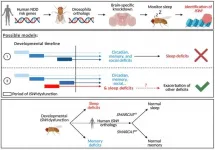(Press-News.org) The trial found that using sensor-based asthma inhalers may improve control of the condition and improve the quality of life for caregivers.
Greatest gains were among non-Hispanic Black participants, who experience more frequent and severe asthma than other groups.
Based on the study results, this asthma intervention should be considered for use by primary care, allergy and pulmonary care providers, to help engage diverse populations of pediatric asthma patients and their caregivers.
CHICAGO (February 17, 2021) -- Sensor-based inhalers integrated into health care providers' clinical workflows may help improve medication adherence and support children with asthma - and their families - to more effectively manage this condition, according to a new Northwestern and Lurie Children's study published in Pediatrics. The study, developed in collaboration with UnitedHealth Group, showed the use of sensor-based inhaler monitoring may help improve asthma symptom control and caregiver quality of life.
Connected inhalers, which use Bluetooth sensors that attach to participants' asthma inhalers to detect medication use and share the data with physicians, may promote adherence to recommended controller medication use and proactively detect worsening of asthma symptoms, according to the study. As a result, this may enable health care providers to intervene more rapidly--before patients become critically ill--and improve communication between patients, caregivers and asthma care providers.
"Emerging connected technologies can help improve patient health, with this randomized-controlled clinical trial showing that pediatric asthma patients with access to inhaler sensors report better asthma control and quality of life than patients who only received a standardized asthma education curriculum," said study lead Dr. Ruchi Gupta, professor of pediatrics at Northwestern University Feinberg School of Medicine, physician at Ann & Robert H. Lurie Children's Hospital of Chicago and the Director of the Center for Food Allergy & Asthma Research (CFAAR).
Children participating in the study were evaluated based on an Asthma Control Test questionnaire, which measured their asthma symptom control on a scale from 0 (poor control) to 27 (well-controlled). Average scores among the intervention increased by 10.1% over the course of the study, with the greatest improvements among non-Hispanic Black participants.
Caregivers who participated in the study were assessed based on a Pediatric Asthma Caregiver's Quality of Life questionnaire, measuring how the sensor-based monitoring adherence affected their day-to-day involvement. Caregivers reported improvement to their quality of life after the first month of the study, which was sustained through the year-long trial, due to greater ease of asthma management.
"This study is another clear example that digital health is here to stay, as it allows for us to stay connected to patients living with chronic disease, provide a level of automated watchfulness, and intercept disease in a timely manner," said Deneen Vojta, MD, Chief Physician Executive for Optum Labs, part of UnitedHealth Group. "This is a terrific example of moving from the best care out there today to the best care possible."
More than 25 million Americans currently have asthma, most of whom are prescribed inhalers designed to prevent and treat asthma attacks. With appropriate management, most asthma patients can control their disease and live symptom-free. However, for patients with moderate-to severe disease, this generally requires daily use of "controller" medications -- typically an inhaled corticosteroid -- as well as occasional use of "rescue" medications (i.e. albuterol).
While previous studies have also explored the feasibility and effectiveness of using these sensor-based mobile interventions to improve asthma management, this study was the first to systematically evaluate its effectiveness in a large, racially/ethnically and socioeconomically diverse sample of children.
All 252 children enrolled in this study had moderate/persistent asthma and were recruited from five clinics (three primary care, one allergy and one pulmonary). Participants were 24% non-Hispanic White, 23% non-Hispanic Black and 40% Hispanic, while 60% were on public insurance. The study lasted 12 months and included assessment at enrollment, three months, six months, nine months, and one year.
INFORMATION:
For an example of how this technology helped one family better manage their 14-year-old's asthma, click here.
Other Northwestern authors include Christopher Warren, PhD, Jamie Fierstein PhD, Kathy Boon, MPH, Madeleine K Kanaley BA, Alexandria Bozen BS, and Kristin Kan MD.
Ann & Robert H. Lurie Children's Hospital of Chicago
Research at Ann & Robert H. Lurie Children's Hospital of Chicago is conducted through the Stanley Manne Children's Research Institute. The Manne Research Institute is focused on improving child health, transforming pediatric medicine and ensuring healthier futures through the relentless pursuit of knowledge. Lurie Children's is ranked as one of the nation's top children's hospitals by U.S. News & World Report. It is the pediatric training ground for Northwestern University Feinberg School of Medicine. Last year, the hospital served more than 220,000 children from 48 states and 49 countries.
About UnitedHealth Group
UnitedHealth Group (NYSE: UNH) is a diversified health care company dedicated to helping people live healthier lives and helping make the health system work better for everyone. UnitedHealth Group offers a broad spectrum of products and services through two distinct platforms: UnitedHealthcare, which provides health care coverage and benefits services; and Optum, which provides information and technology-enabled health services. For more information, visit UnitedHealth Group at http://www.unitedhealthgroup.com or follow @UnitedHealthGrp on Twitter.
Numerous studies have shown that trained dogs can detect many kinds of disease -- including lung, breast, ovarian, bladder, and prostate cancers, and possibly Covid-19 -- simply through smell. In some cases, involving prostate cancer for example, the dogs had a 99 percent success rate in detecting the disease by sniffing patients' urine samples.
But it takes time to train such dogs, and their availability and time is limited. Scientists have been hunting for ways of automating the amazing olfactory capabilities of the canine nose and brain, in a compact device. Now, a team of researchers at MIT and other institutions has come up with a system that can detect the chemical and microbial content of an air sample with ...
As people age, a normal brain protein known as amyloid beta often starts to collect into harmful amyloid plaques in the brain. Such plaques can be the first step on the path to Alzheimer's dementia. When they form around blood vessels in the brain, a condition known as cerebral amyloid angiopathy, the plaques also raise the risk of strokes.
Several antibodies that target amyloid plaques have been studied as experimental treatments for Alzheimer's disease. Such antibodies also may have the potential to treat cerebral amyloid angiopathy, although they haven't yet been evaluated in clinical trials. ...
An international team led by researchers at the Centre for Palaeogenetics in Stockholm has sequenced DNA recovered from mammoth remains that are up to 1.2 million years old. The analyses show that the Columbian mammoth that inhabited North America during the last ice age was a hybrid between the woolly mammoth and a previously unknown genetic lineage of mammoth. In addition, the study provides new insights into when and how fast mammoths became adapted to cold climate. These findings are published today in Nature.
Around one million years ago there were no woolly or Columbian mammoths, as they had not yet evolved. This was the time of their predecessor, the ...
DURHAM, N.C. -- A new pair of studies from a Duke research team's long-term work in New Zealand make the case that mental health struggles in early life can lead to poorer physical health and advanced aging in adulthood.
But because mental health problems peak early in life and can be identified, the researchers say that more investment in prompt mental health care could be used to prevent later diseases and lower societal healthcare costs.
"The same people who experience psychiatric conditions when they are young go on to experience excess age-related physical diseases and neurodegenerative diseases when they are older adults," explained Terrie Moffitt, the Nannerl O. Keohane professor ...
A University of Sydney-led international team of scientists has revealed the shape of one of the most important molecular machines in our cellsthe glutamate transporter, helping to explain how our brain cells communicate with one another.
Glutamate transporters are tiny proteins on the surface of all our cells that shut on and off the chemical signals that have a big role in making sure all cell-to-cell talk runs smoothly. They are also involved in nerve signalling, metabolism and learning and memory.
The researchers captured the transporters in exquisite detail using cryogenic electron microscopy (cryo-EM), showing they look like a 'twisted elevator' embedded in the cell membrane.
This world-first discovery ...
Almost one in five people lacks the protein α-actinin-3 in their muscle fibre. Researchers at Karolinska Institutet in Sweden now show that more of the skeletal muscle of these individuals comprises slow-twitch muscle fibres, which are more durable and energy-efficient and provide better tolerance to low temperatures than fast-twitch muscle fibres. The results are published in the scientific journal The American Journal of Human Genetics.
Skeletal muscle comprises fast-twitch (white) fibres that fatigue quickly and slow-twitch (red) fibres that are more resistant to fatigue. The protein α-actinin-3, which is found only ...
Robotic dogs, laughter therapy and mindfulness are some of the ways that might help people - particularly the elderly - cope with loneliness and social isolation while social distancing, say researchers at the University of Cambridge.
A team at Cambridge's School of Medicine carried out a systematic review looking at the existing evidence on different approaches to tackling loneliness and social isolation. While all the individual studies were carried out pre-pandemic, the team considered which approaches might be feasible when people are still required to socially distance. Their results are published today in PLOS ONE.
At the start of the pandemic in the UK, over 1.5 million people were told they must self-isolate ...
Lakes underneath the Antarctic ice sheet could be more hospitable than previously thought, allowing them to host more microbial life.
This is the finding of a new study that could help researchers determine the best spots to search for microbes that could be unique to the region, having been isolated and evolving alone for millions of years. The work could even provide insights into similar lakes beneath the surfaces of icy moons orbiting Jupiter and Saturn, and the southern ice cap on Mars.
Lakes can form beneath the thick ice sheet of Antarctica where the weight of ice causes immense pressure at the base, lowering the melting point of ice. This, coupled with gentle heating from rocks below and the insulation provided by the ice from the cold air above, allows pools of liquid water ...
WASHINGTON --- Recent data reveals that gay men living with HIV report having supportive relationships with family, friends, or in informal relationships rather than with primary romantic partners, while gay men who are HIV negative report having relationships mainly with primary partners. Additionally, gay men living with HIV were more likely to report no primary or secondary supportive partnerships compared to men who are HIV negative. The analysis was led by researchers at Georgetown University Medical Center.
Along with successful HIV treatments, it is known that the presence of social support impacts long-term survival among men living with HIV. However, little has been known about the types of ...
PHILADELPHIA - The mutation of a gene that has been associated with neurodevelopmental disorders like autism spectrum disorder led to marked sleep disturbances in fruit flies, according to a new study from scientists in the Perelman School of Medicine at the University of Pennsylvania. The findings, published Wednesday in Science Advances, provide further evidence that sleep is linked to early neurodevelopmental processes and could guide future treatments for patients.
While sleep disruption is a commonly reported symptom across neurodevelopmental disorders, including autism, it is often treated clinically as a "secondary effect" ...



